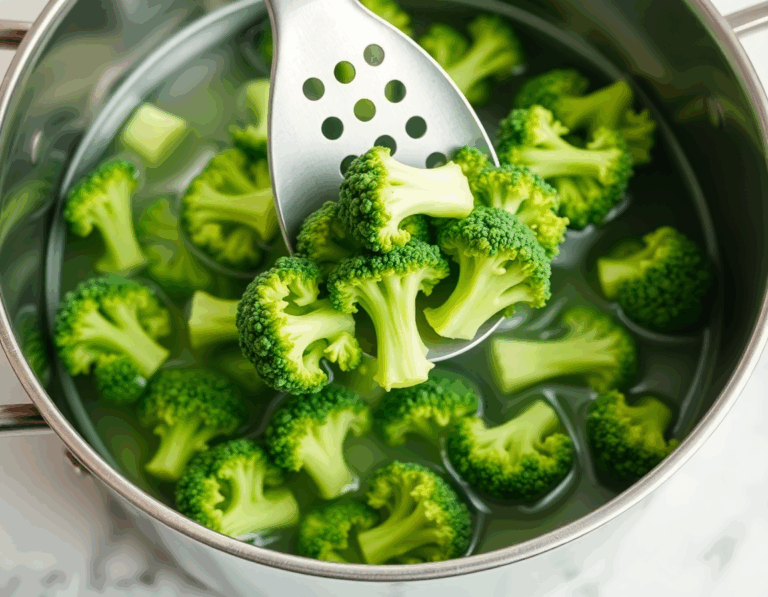Ah, broccoli. That humble green veggie we often overlook but—oh boy—when paired with a zesty lemon, it dances on your taste buds like a summer breeze. Just imagine: a quick whirl of the blender, a pot of pasta bubbling away, and suddenly, you’ve got a dish that’s as fresh as a morning walk through a dewy garden.
Steps
- Begin by heating a large pot of well-salted water until it reaches a rolling boil.
- Add the broccoli florets to the boiling water, cooking them for about 3 minutes until they become tender. Use a slotted spoon to remove the broccoli, keeping the boiling water in the pot.
- Place the broccoli in a food processor, and add the pasta to the pot. Cook the pasta until it is just al dente.
- While the pasta cooks, prepare the pesto by combining basil, Parmesan, pine nuts, spinach, garlic, lemon zest, juice, salt, and pepper in the food processor. Gradually add olive oil while pulsing until the mixture becomes smooth. Pour in ¼ cup of the pasta’s starchy water to achieve a creamy texture.
- Once the pasta reaches al dente, save an additional 1/2 cup of the pasta water before draining. Return the drained pasta to the pot and mix in the broccoli pesto. If necessary, add some reserved pasta water to achieve the desired consistency.
- Serve the pasta warm, topped with extra Parmesan and a sprinkle of black pepper. Enjoy your dish!
Ingredients
- 1 pound of uncooked pasta (such as mezzi rigatoni)
- 2 1/2 cups (8 ounces) of broccoli florets
- 1 cup (1 ounce) of fresh basil leaves, packed tightly
- 1 cup (1 ounce) of freshly grated Parmesan cheese
- 1/3 cup of toasted pine nuts or slivered almonds
- 1 large handful (2 ounces) of fresh baby spinach
- 2 large cloves of garlic
- 1 large lemon, for zest and juice
- 1/2 teaspoon of fine sea salt
- 1/2 teaspoon of freshly ground black pepper
- 1/2 cup of extra-virgin olive oil
FAQ
- Can I use frozen broccoli florets instead of fresh ones?
- Yes, you can use frozen broccoli florets. Just ensure they are thawed and drained properly before adding them to the boiling water.
- What type of pasta works best for this recipe?
- While mezzi rigatoni is recommended, you can use any type of short pasta or long noodles you prefer. Just be sure to salt the pasta water generously to enhance the pasta’s flavor.
- Can I substitute the pine nuts or almonds in the pesto?
- Absolutely, you can replace pine nuts or almonds with your preferred seeds, such as sunflower seeds or pepitas, for a nut-free alternative.
- Is it possible to serve this dish cold?
- Yes, this lemony broccoli pesto pasta is delicious both warm and cold. Rinse the al dente pasta with cold water before mixing it with the pesto for a refreshing pasta salad.
- How can I make the pesto creamier?
- To make a creamier pesto sauce, you can add a splash of cream or blend in some starchy pasta water until the desired consistency is achieved.
Tips
- Don’t Overcook the Pasta: Taste-test the pasta regularly during the last few minutes of cooking to ensure it reaches a firm, al dente texture, rather than relying solely on package instructions.
- Toast the Nuts: Enhance the flavor of your pesto by taking the extra time to lightly toast the pine nuts or almonds. You can do this in a sauté pan over medium-low heat or in the oven, but make sure to watch them closely to prevent burning.
- Blend Pesto Smoothly: For a creamy pesto, blend in some starchy pasta water until you achieve a smooth consistency. This will help integrate the flavors and texture beautifully.
- Taste Before Serving: Before mixing the pesto with the pasta, taste it and adjust the seasoning as needed with extra salt, pepper, or lemon juice to suit your preference.
Equipment
- Food Processor – Essential for blending the broccoli, basil, nuts, and other ingredients into a smooth pesto.
- Microplane Grater – Useful for finely grating Parmesan cheese and zesting the lemon.
- Spider Strainer or Slotted Spoon – Helpful for transferring broccoli from the boiling water without needing to drain the entire pot.

